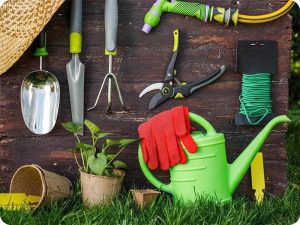
Do you find yourself facing a pile of grimy garden tools after a productive day in the yard? As a passionate gardener, you understand the importance of maintaining your tools to ensure they remain efficient and durable. One of the most effective and eco-friendly ways to clean your garden tools is by using vinegar. Yes, that’s right, the same vinegar you use in your kitchen! In this article, we’re going to delve into the nitty-gritty of how to clean garden tools with vinegar. Get ready to transform your dirty tools into sparkling, well-maintained essentials that will help you create the garden of your dreams.
Why Use Vinegar for Cleaning Garden Tools
Vinegar is a natural wonder that has been used for cleaning purposes for centuries. Its acidic properties make it a formidable foe against dirt, grime, and rust. When it comes to cleaning garden tools, vinegar offers several advantages:
- Non-Toxic: Vinegar is safe for the environment and won’t harm you or your plants.
- Cost-Effective: It’s an affordable cleaning solution that delivers impressive results.
- Antibacterial Properties: Vinegar’s acidic nature helps kill germs and bacteria that might be lingering on your tools.
- Eco-Friendly: By using vinegar, you’re reducing your reliance on harsh chemicals that can harm the ecosystem.
Explore does clove oil kill bed bugs.
Items You’ll Need
Before you embark on your journey to clean your garden tools with vinegar, gather the following items:
- A bucket or container large enough to hold your tools
- White vinegar (avoid using colored or flavored vinegar)
- Water
- Scrubbing brush or steel wool
- Dish soap
- Soft cloth or sponge
- Protective gloves (optional but recommended)
- Towels for drying
Step-by-Step Guide to Cleaning Garden Tools with Vinegar
Step 1: Gather Your Supplies
Start by gathering all the necessary supplies mentioned above. Having everything ready before you begin will make the process smoother.
Step 2: Remove Excess Dirt
Using a brush or your hands, remove excess dirt and debris from your garden tools. This step will make the cleaning process more effective.
Step 3: Prepare the Vinegar Solution
Create a cleaning solution by mixing equal parts of white vinegar and water in your bucket or container. You can also add a small amount of dish soap to enhance the cleaning power.
Step 4: Soak Your Tools
Place your garden tools in the vinegar solution, ensuring they are fully submerged. Let them soak for at least 15 to 30 minutes, depending on the level of grime.
Step 5: Scrub Away Residue
After soaking, use a scrubbing brush or steel wool to gently scrub away any remaining dirt or rust. The vinegar solution will have loosened the residue, making it easier to remove.
Step 6: Rinse and Dry
Rinse your tools thoroughly with clean water to remove any vinegar residue. Dry them with a towel or let them air-dry in the sun. For metal parts, you can also apply a thin layer of oil to prevent rust.
Benefits of Using Vinegar for Cleaning
The benefits of using vinegar for cleaning your garden tools go beyond just getting them looking pristine. Vinegar’s natural properties contribute to the overall health of your garden:
- Prevents Rust: Vinegar helps remove rust and prevents its future formation, extending the life of your tools.
- Non-Toxic: Unlike chemical cleaners, vinegar won’t leave harmful residues that can affect your plants.
- pH Balance: Vinegar’s acidity can help balance the pH of the soil when traces are left on your tools and come into contact with the earth.
- Safe for Plants: Even if some vinegar residue finds its way to your garden, it won’t harm your plants.
Tips for Maintaining Your Garden Tools
Now that your tools are clean, it’s essential to maintain them for long-lasting use:
- Regular Cleaning: Make cleaning your tools a routine after every gardening session.
- Drying: Always ensure your tools are completely dry before storing them to prevent rust.
- Sharpening: Keep your cutting tools sharp for efficient and clean cuts.
- Storage: Hang your tools or store them in a dry area to avoid moisture buildup.
Common Mistakes to Avoid
While using vinegar for cleaning garden tools is a fantastic approach, there are a few mistakes to steer clear of:
- Using Colored Vinegar: Colored vinegar can stain your tools, so stick to white vinegar.
- Skipping Drying: Failing to dry your tools thoroughly can lead to rust.
- Not Wearing Gloves: Vinegar can be harsh on the skin, so protect your hands with gloves.
- Using Too Much Dish Soap: A little dish soap goes a long way; using too much can leave a soapy residue.
Conclusion
Cleaning your garden tools with vinegar is an easy, eco-friendly, and effective way to keep them in top shape. By following the simple steps outlined in this article, you’re not only maintaining your tools but also contributing to the health and beauty of your garden. So, the next time you’re faced with grimy garden tools, reach for that trusty bottle of vinegar and watch the magic unfold!
Frequently Asked Questions
FAQ 1: Can I use any type of vinegar?
Absolutely! However, white vinegar is the most recommended type for cleaning purposes due to its clear color and high acidity.
FAQ 2: Will vinegar damage the metal parts of my tools?
No, vinegar actually helps prevent rust and remove rust from metal surfaces, ensuring your tools remain in good condition.
FAQ 3: How often should I clean my garden tools?
Try to clean them after each gardening session. Regular cleaning prevents the buildup of dirt and rust.
FAQ 4: Can I use this method for all types of garden tools?
Yes, this method is suitable for most garden tools, from pruners to shovels. Just be cautious with delicate tools that might be affected by vinegar.
FAQ 5: Are there any safety precautions I should take when using vinegar?
While vinegar is generally safe, it’s a good idea to wear gloves to protect your hands, especially if you have sensitive skin. Also, avoid inhaling vinegar fumes in enclosed spaces.





